Macroeconomics Assignment: Labor Market, Wage, and Demand Analysis
VerifiedAdded on 2023/06/10
|17
|1989
|451
Homework Assignment
AI Summary
This macroeconomics assignment solution analyzes various aspects of labor markets, wage determination, and demand. The solution begins by examining the value of marginal product of labor, the demand curve for labor, and the impact of wage rates on hiring decisions. It further explores cross-price elasticity of capital with respect to labor wages, determining whether they are complements or substitutes. The assignment then delves into market equilibrium, illustrating the effects of shifts in supply and demand for newspaper journalists and online journalists. The analysis also includes the impact of technological advancements on labor markets. Finally, the solution addresses the effects of minimum wage laws and wage subsidies on labor supply, labor demand, and employment levels, using both graphical representations and mathematical calculations to determine equilibrium wages and employment.
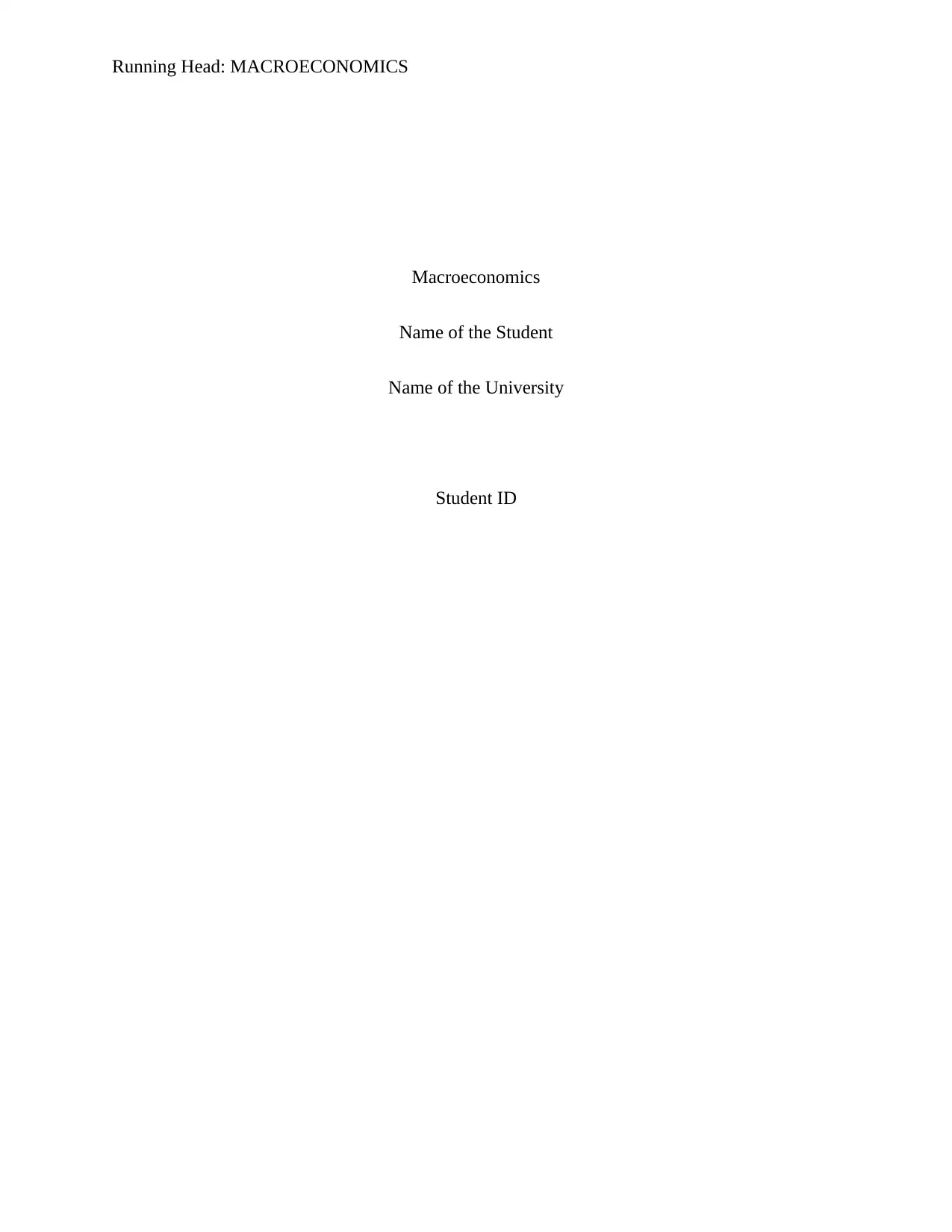
Running Head: MACROECONOMICS
Macroeconomics
Name of the Student
Name of the University
Student ID
Macroeconomics
Name of the Student
Name of the University
Student ID
Paraphrase This Document
Need a fresh take? Get an instant paraphrase of this document with our AI Paraphraser
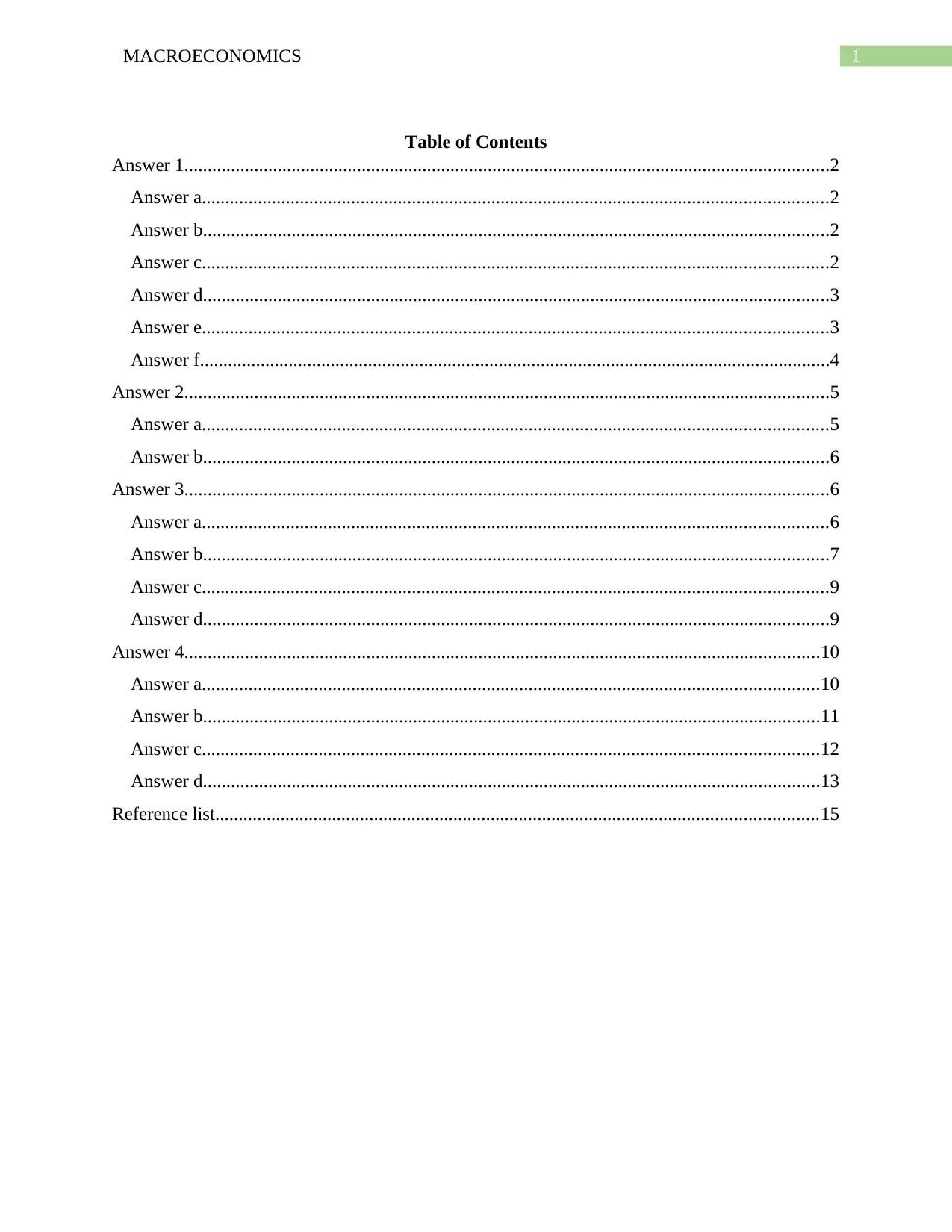
1MACROECONOMICS
Table of Contents
Answer 1..........................................................................................................................................2
Answer a......................................................................................................................................2
Answer b......................................................................................................................................2
Answer c......................................................................................................................................2
Answer d......................................................................................................................................3
Answer e......................................................................................................................................3
Answer f.......................................................................................................................................4
Answer 2..........................................................................................................................................5
Answer a......................................................................................................................................5
Answer b......................................................................................................................................6
Answer 3..........................................................................................................................................6
Answer a......................................................................................................................................6
Answer b......................................................................................................................................7
Answer c......................................................................................................................................9
Answer d......................................................................................................................................9
Answer 4........................................................................................................................................10
Answer a....................................................................................................................................10
Answer b....................................................................................................................................11
Answer c....................................................................................................................................12
Answer d....................................................................................................................................13
Reference list.................................................................................................................................15
Table of Contents
Answer 1..........................................................................................................................................2
Answer a......................................................................................................................................2
Answer b......................................................................................................................................2
Answer c......................................................................................................................................2
Answer d......................................................................................................................................3
Answer e......................................................................................................................................3
Answer f.......................................................................................................................................4
Answer 2..........................................................................................................................................5
Answer a......................................................................................................................................5
Answer b......................................................................................................................................6
Answer 3..........................................................................................................................................6
Answer a......................................................................................................................................6
Answer b......................................................................................................................................7
Answer c......................................................................................................................................9
Answer d......................................................................................................................................9
Answer 4........................................................................................................................................10
Answer a....................................................................................................................................10
Answer b....................................................................................................................................11
Answer c....................................................................................................................................12
Answer d....................................................................................................................................13
Reference list.................................................................................................................................15
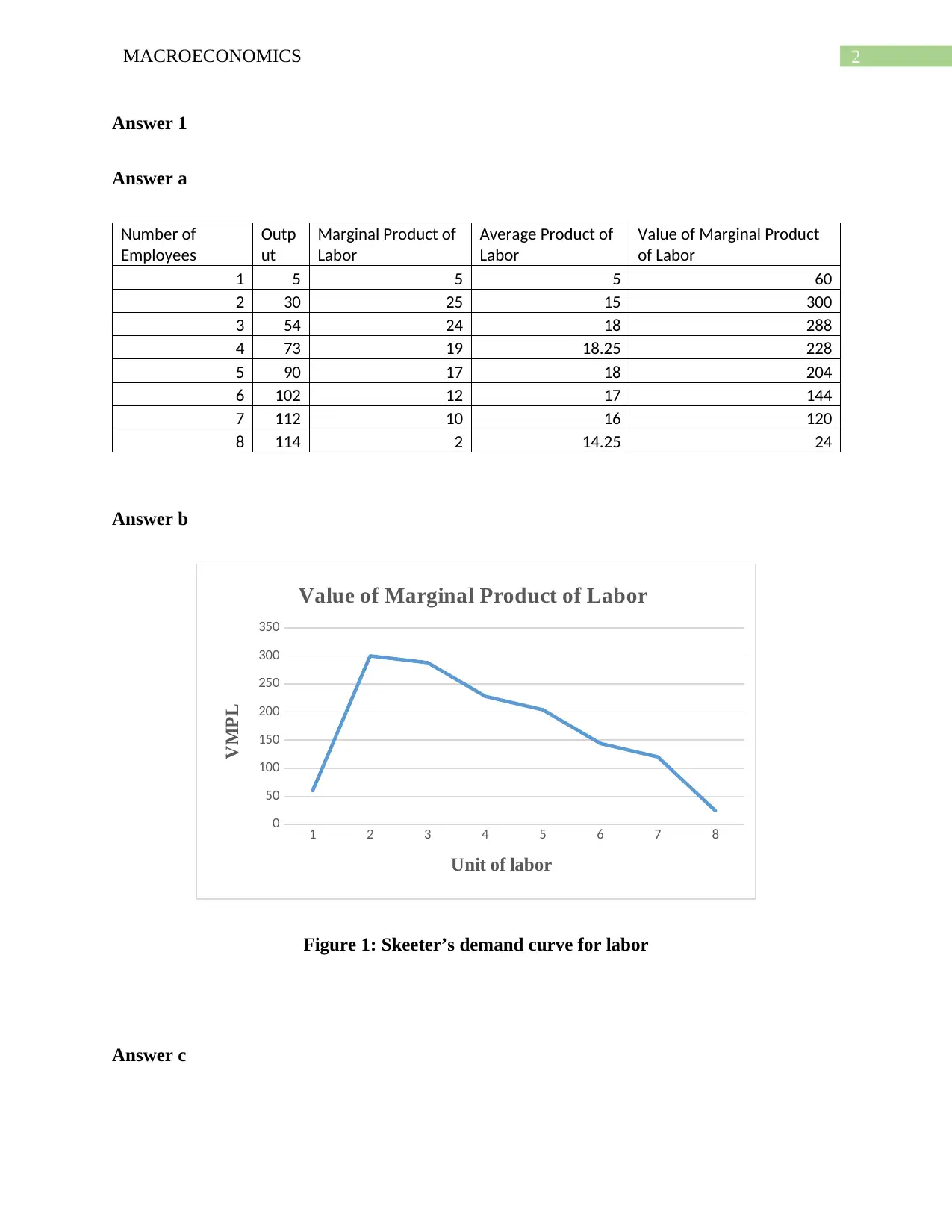
2MACROECONOMICS
Answer 1
Answer a
Number of
Employees
Outp
ut
Marginal Product of
Labor
Average Product of
Labor
Value of Marginal Product
of Labor
1 5 5 5 60
2 30 25 15 300
3 54 24 18 288
4 73 19 18.25 228
5 90 17 18 204
6 102 12 17 144
7 112 10 16 120
8 114 2 14.25 24
Answer b
1 2 3 4 5 6 7 8
0
50
100
150
200
250
300
350
Value of Marginal Product of Labor
Unit of labor
VMPL
Figure 1: Skeeter’s demand curve for labor
Answer c
Answer 1
Answer a
Number of
Employees
Outp
ut
Marginal Product of
Labor
Average Product of
Labor
Value of Marginal Product
of Labor
1 5 5 5 60
2 30 25 15 300
3 54 24 18 288
4 73 19 18.25 228
5 90 17 18 204
6 102 12 17 144
7 112 10 16 120
8 114 2 14.25 24
Answer b
1 2 3 4 5 6 7 8
0
50
100
150
200
250
300
350
Value of Marginal Product of Labor
Unit of labor
VMPL
Figure 1: Skeeter’s demand curve for labor
Answer c
⊘ This is a preview!⊘
Do you want full access?
Subscribe today to unlock all pages.

Trusted by 1+ million students worldwide
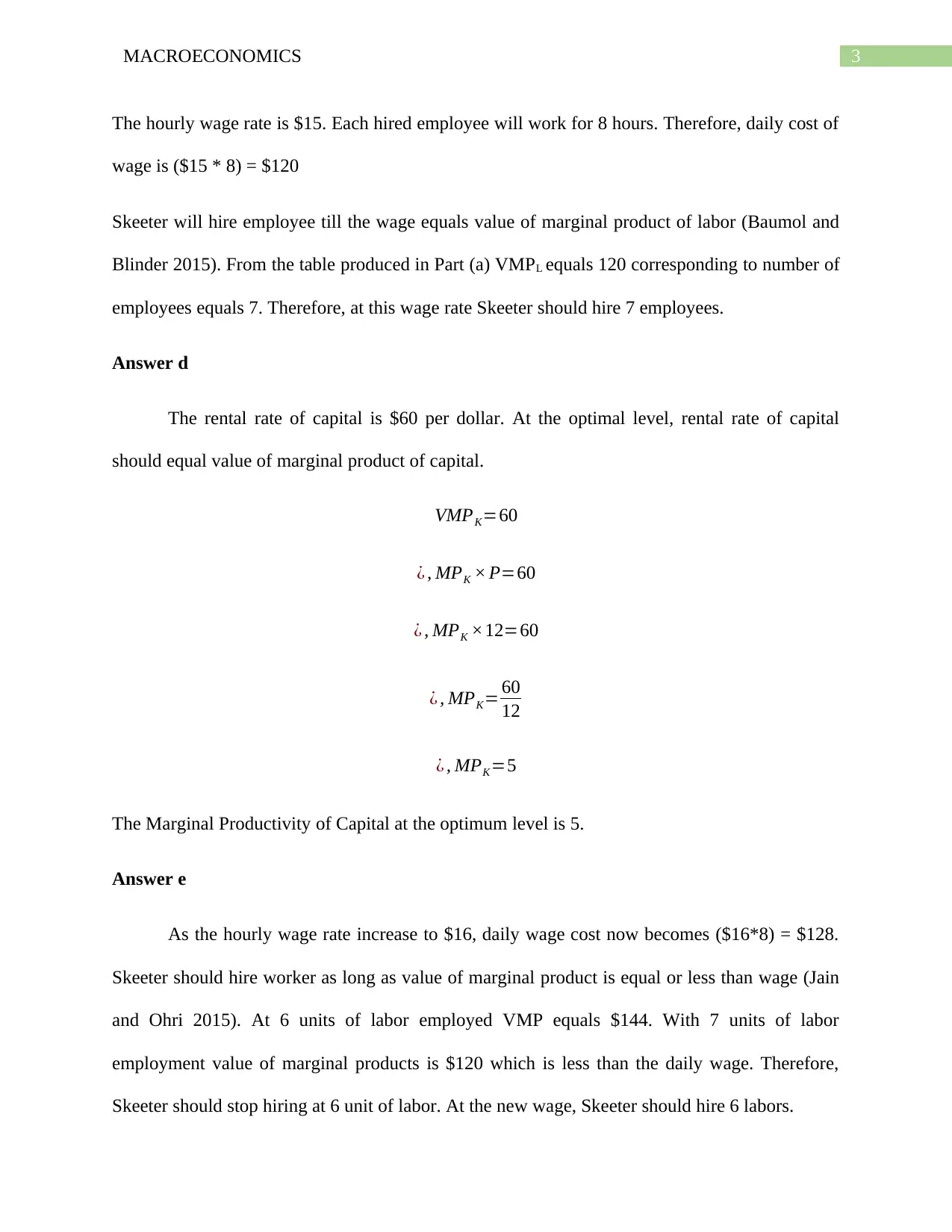
3MACROECONOMICS
The hourly wage rate is $15. Each hired employee will work for 8 hours. Therefore, daily cost of
wage is ($15 * 8) = $120
Skeeter will hire employee till the wage equals value of marginal product of labor (Baumol and
Blinder 2015). From the table produced in Part (a) VMPL equals 120 corresponding to number of
employees equals 7. Therefore, at this wage rate Skeeter should hire 7 employees.
Answer d
The rental rate of capital is $60 per dollar. At the optimal level, rental rate of capital
should equal value of marginal product of capital.
VMPK=60
¿ , MPK × P=60
¿ , MPK ×12=60
¿ , MPK= 60
12
¿ , MPK=5
The Marginal Productivity of Capital at the optimum level is 5.
Answer e
As the hourly wage rate increase to $16, daily wage cost now becomes ($16*8) = $128.
Skeeter should hire worker as long as value of marginal product is equal or less than wage (Jain
and Ohri 2015). At 6 units of labor employed VMP equals $144. With 7 units of labor
employment value of marginal products is $120 which is less than the daily wage. Therefore,
Skeeter should stop hiring at 6 unit of labor. At the new wage, Skeeter should hire 6 labors.
The hourly wage rate is $15. Each hired employee will work for 8 hours. Therefore, daily cost of
wage is ($15 * 8) = $120
Skeeter will hire employee till the wage equals value of marginal product of labor (Baumol and
Blinder 2015). From the table produced in Part (a) VMPL equals 120 corresponding to number of
employees equals 7. Therefore, at this wage rate Skeeter should hire 7 employees.
Answer d
The rental rate of capital is $60 per dollar. At the optimal level, rental rate of capital
should equal value of marginal product of capital.
VMPK=60
¿ , MPK × P=60
¿ , MPK ×12=60
¿ , MPK= 60
12
¿ , MPK=5
The Marginal Productivity of Capital at the optimum level is 5.
Answer e
As the hourly wage rate increase to $16, daily wage cost now becomes ($16*8) = $128.
Skeeter should hire worker as long as value of marginal product is equal or less than wage (Jain
and Ohri 2015). At 6 units of labor employed VMP equals $144. With 7 units of labor
employment value of marginal products is $120 which is less than the daily wage. Therefore,
Skeeter should stop hiring at 6 unit of labor. At the new wage, Skeeter should hire 6 labors.
Paraphrase This Document
Need a fresh take? Get an instant paraphrase of this document with our AI Paraphraser
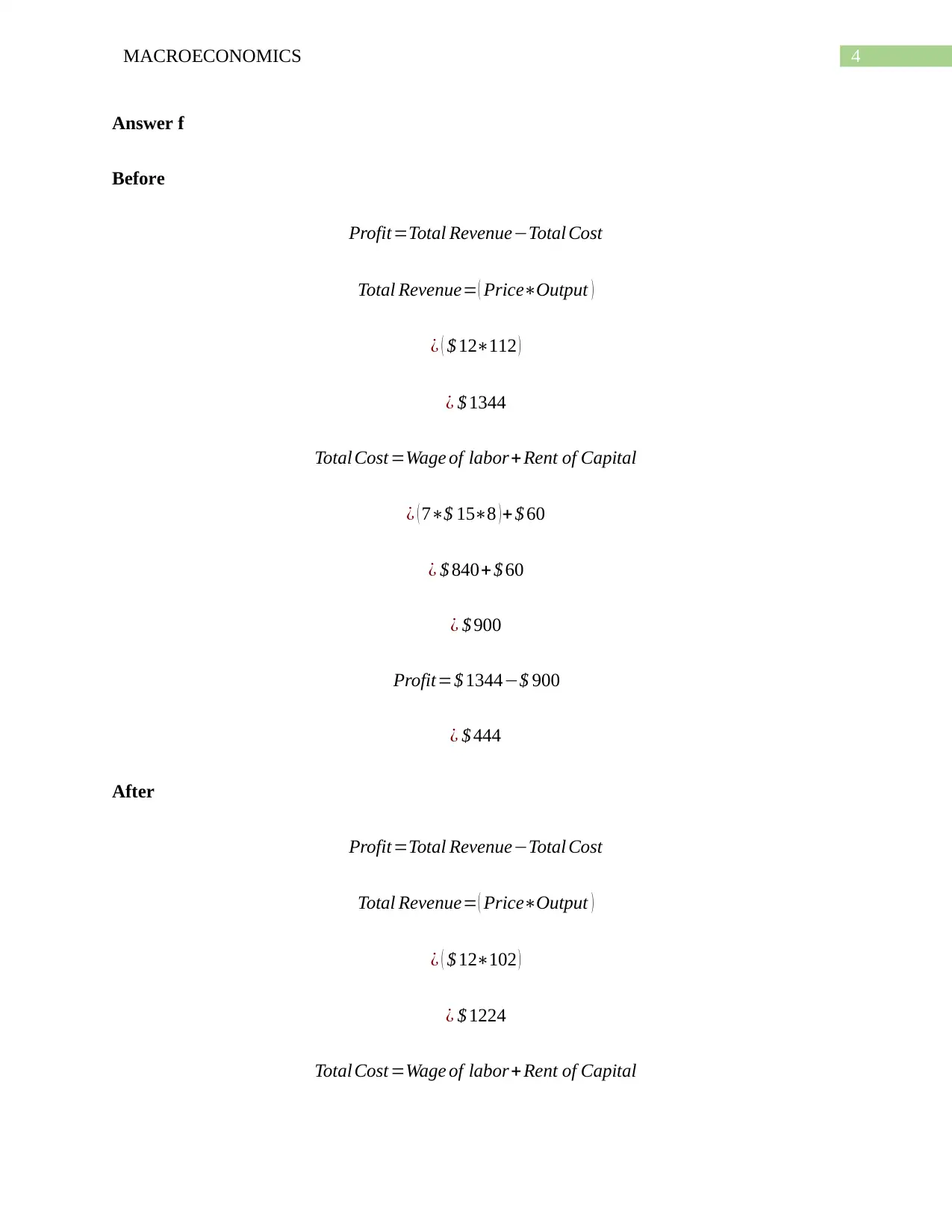
4MACROECONOMICS
Answer f
Before
Profit=Total Revenue−Total Cost
Total Revenue= ( Price∗Output )
¿ ( $ 12∗112 )
¿ $ 1344
Total Cost =Wage of labor+Rent of Capital
¿ ( 7∗$ 15∗8 )+ $ 60
¿ $ 840+ $ 60
¿ $ 900
Profit=$ 1344−$ 900
¿ $ 444
After
Profit=Total Revenue−Total Cost
Total Revenue= ( Price∗Output )
¿ ( $ 12∗102 )
¿ $ 1224
Total Cost =Wage of labor+Rent of Capital
Answer f
Before
Profit=Total Revenue−Total Cost
Total Revenue= ( Price∗Output )
¿ ( $ 12∗112 )
¿ $ 1344
Total Cost =Wage of labor+Rent of Capital
¿ ( 7∗$ 15∗8 )+ $ 60
¿ $ 840+ $ 60
¿ $ 900
Profit=$ 1344−$ 900
¿ $ 444
After
Profit=Total Revenue−Total Cost
Total Revenue= ( Price∗Output )
¿ ( $ 12∗102 )
¿ $ 1224
Total Cost =Wage of labor+Rent of Capital
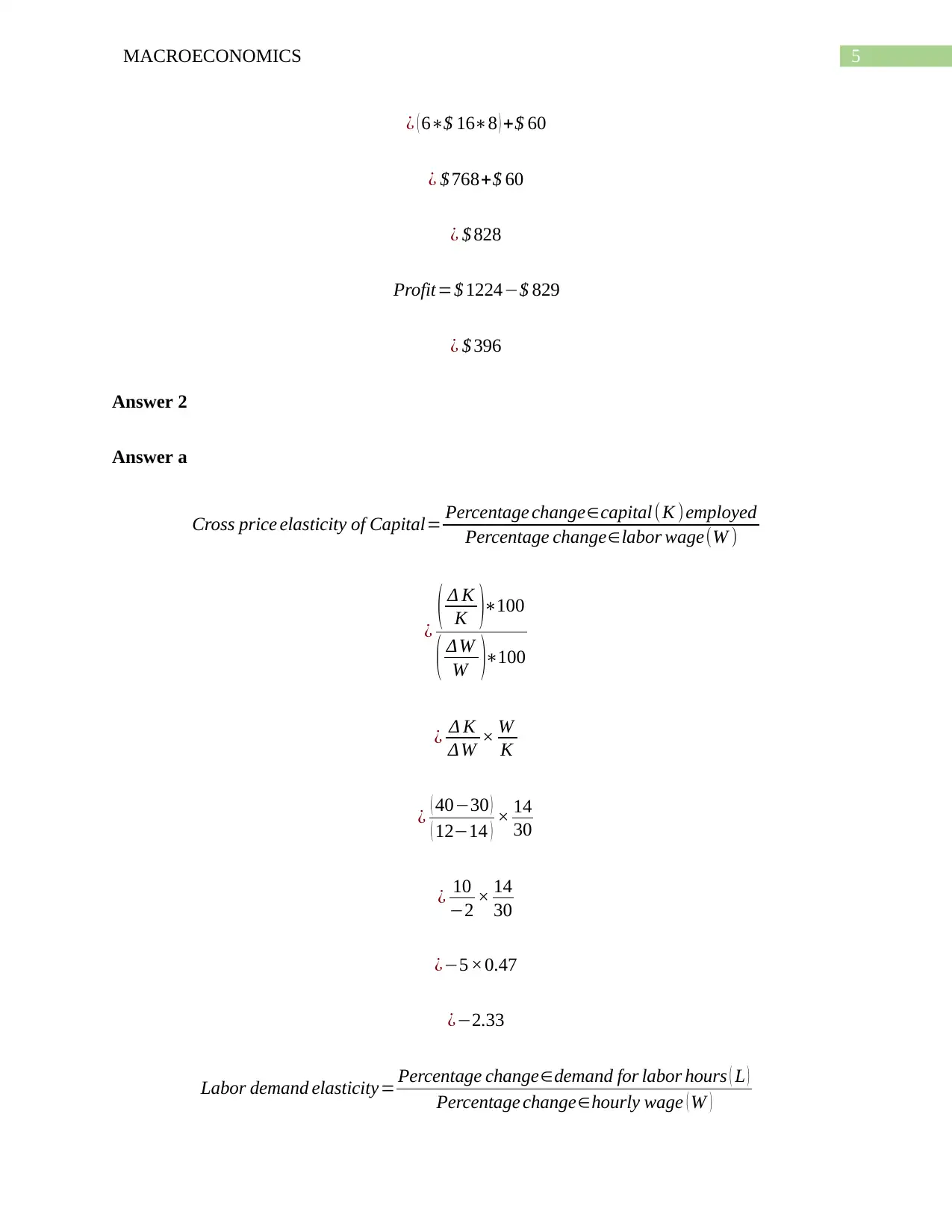
5MACROECONOMICS
¿ ( 6∗$ 16∗8 ) +$ 60
¿ $ 768+$ 60
¿ $ 828
Profit=$ 1224−$ 829
¿ $ 396
Answer 2
Answer a
Cross price elasticity of Capital= Percentage change∈capital (K )employed
Percentage change∈labor wage(W )
¿ ( Δ K
K )∗100
( ΔW
W )∗100
¿ Δ K
ΔW × W
K
¿ ( 40−30 )
( 12−14 ) × 14
30
¿ 10
−2 × 14
30
¿−5 ×0.47
¿−2.33
Labor demand elasticity= Percentage change∈demand for labor hours ( L )
Percentage change∈hourly wage ( W )
¿ ( 6∗$ 16∗8 ) +$ 60
¿ $ 768+$ 60
¿ $ 828
Profit=$ 1224−$ 829
¿ $ 396
Answer 2
Answer a
Cross price elasticity of Capital= Percentage change∈capital (K )employed
Percentage change∈labor wage(W )
¿ ( Δ K
K )∗100
( ΔW
W )∗100
¿ Δ K
ΔW × W
K
¿ ( 40−30 )
( 12−14 ) × 14
30
¿ 10
−2 × 14
30
¿−5 ×0.47
¿−2.33
Labor demand elasticity= Percentage change∈demand for labor hours ( L )
Percentage change∈hourly wage ( W )
⊘ This is a preview!⊘
Do you want full access?
Subscribe today to unlock all pages.

Trusted by 1+ million students worldwide
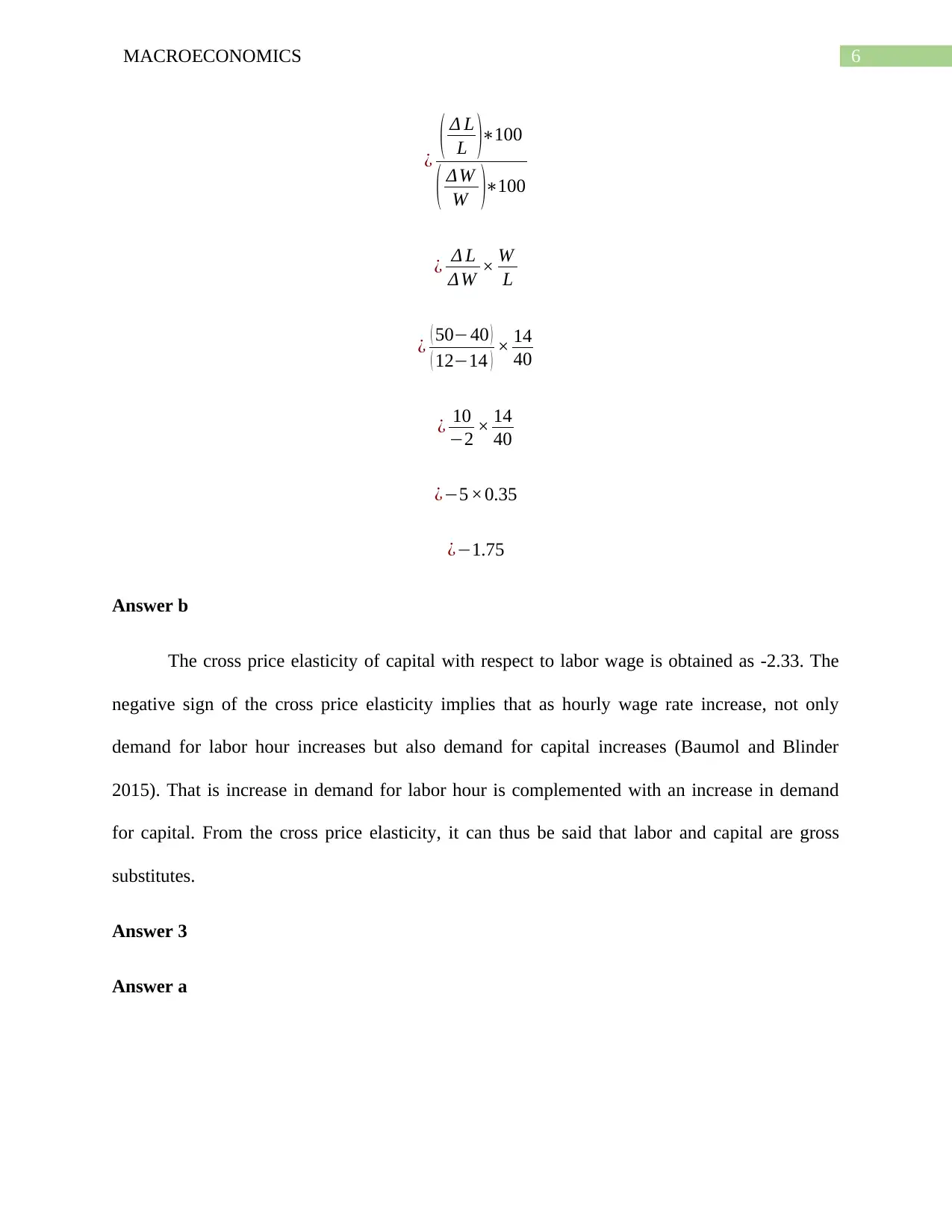
6MACROECONOMICS
¿ ( Δ L
L )∗100
( ΔW
W )∗100
¿ Δ L
ΔW × W
L
¿ ( 50−40 )
( 12−14 ) × 14
40
¿ 10
−2 × 14
40
¿−5 ×0.35
¿−1.75
Answer b
The cross price elasticity of capital with respect to labor wage is obtained as -2.33. The
negative sign of the cross price elasticity implies that as hourly wage rate increase, not only
demand for labor hour increases but also demand for capital increases (Baumol and Blinder
2015). That is increase in demand for labor hour is complemented with an increase in demand
for capital. From the cross price elasticity, it can thus be said that labor and capital are gross
substitutes.
Answer 3
Answer a
¿ ( Δ L
L )∗100
( ΔW
W )∗100
¿ Δ L
ΔW × W
L
¿ ( 50−40 )
( 12−14 ) × 14
40
¿ 10
−2 × 14
40
¿−5 ×0.35
¿−1.75
Answer b
The cross price elasticity of capital with respect to labor wage is obtained as -2.33. The
negative sign of the cross price elasticity implies that as hourly wage rate increase, not only
demand for labor hour increases but also demand for capital increases (Baumol and Blinder
2015). That is increase in demand for labor hour is complemented with an increase in demand
for capital. From the cross price elasticity, it can thus be said that labor and capital are gross
substitutes.
Answer 3
Answer a
Paraphrase This Document
Need a fresh take? Get an instant paraphrase of this document with our AI Paraphraser
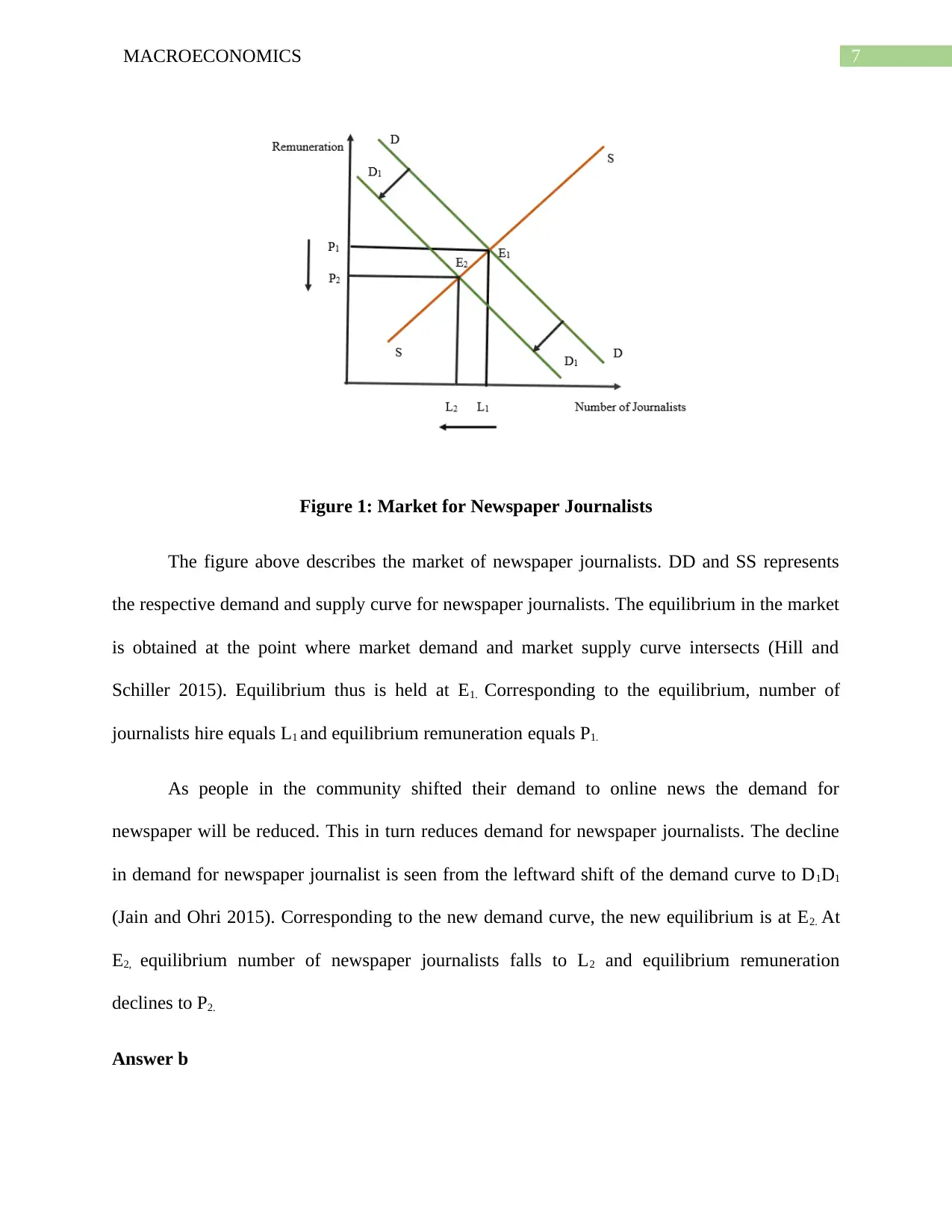
7MACROECONOMICS
Figure 1: Market for Newspaper Journalists
The figure above describes the market of newspaper journalists. DD and SS represents
the respective demand and supply curve for newspaper journalists. The equilibrium in the market
is obtained at the point where market demand and market supply curve intersects (Hill and
Schiller 2015). Equilibrium thus is held at E1. Corresponding to the equilibrium, number of
journalists hire equals L1 and equilibrium remuneration equals P1.
As people in the community shifted their demand to online news the demand for
newspaper will be reduced. This in turn reduces demand for newspaper journalists. The decline
in demand for newspaper journalist is seen from the leftward shift of the demand curve to D1D1
(Jain and Ohri 2015). Corresponding to the new demand curve, the new equilibrium is at E2. At
E2, equilibrium number of newspaper journalists falls to L2 and equilibrium remuneration
declines to P2.
Answer b
Figure 1: Market for Newspaper Journalists
The figure above describes the market of newspaper journalists. DD and SS represents
the respective demand and supply curve for newspaper journalists. The equilibrium in the market
is obtained at the point where market demand and market supply curve intersects (Hill and
Schiller 2015). Equilibrium thus is held at E1. Corresponding to the equilibrium, number of
journalists hire equals L1 and equilibrium remuneration equals P1.
As people in the community shifted their demand to online news the demand for
newspaper will be reduced. This in turn reduces demand for newspaper journalists. The decline
in demand for newspaper journalist is seen from the leftward shift of the demand curve to D1D1
(Jain and Ohri 2015). Corresponding to the new demand curve, the new equilibrium is at E2. At
E2, equilibrium number of newspaper journalists falls to L2 and equilibrium remuneration
declines to P2.
Answer b
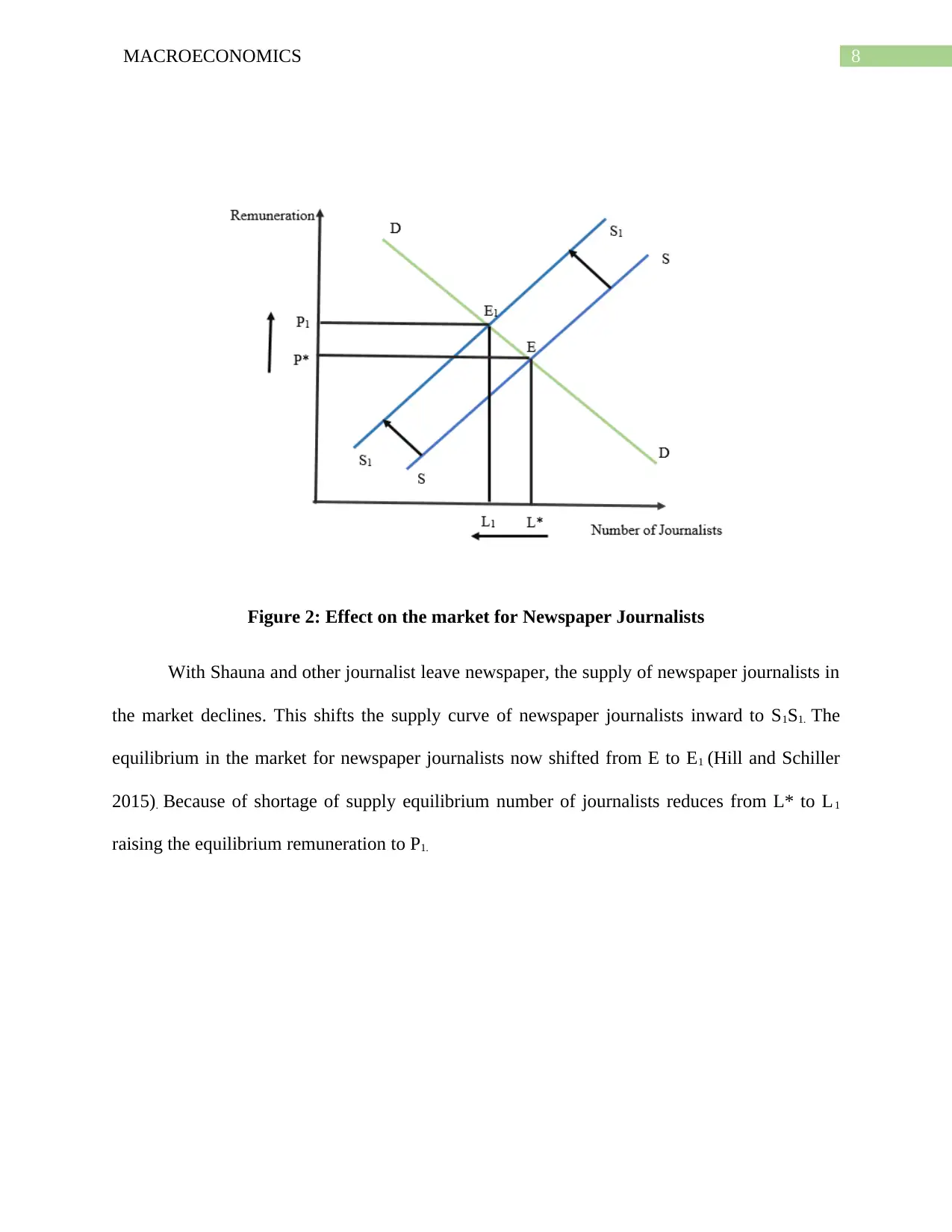
8MACROECONOMICS
Figure 2: Effect on the market for Newspaper Journalists
With Shauna and other journalist leave newspaper, the supply of newspaper journalists in
the market declines. This shifts the supply curve of newspaper journalists inward to S1S1. The
equilibrium in the market for newspaper journalists now shifted from E to E1 (Hill and Schiller
2015). Because of shortage of supply equilibrium number of journalists reduces from L* to L1
raising the equilibrium remuneration to P1.
Figure 2: Effect on the market for Newspaper Journalists
With Shauna and other journalist leave newspaper, the supply of newspaper journalists in
the market declines. This shifts the supply curve of newspaper journalists inward to S1S1. The
equilibrium in the market for newspaper journalists now shifted from E to E1 (Hill and Schiller
2015). Because of shortage of supply equilibrium number of journalists reduces from L* to L1
raising the equilibrium remuneration to P1.
⊘ This is a preview!⊘
Do you want full access?
Subscribe today to unlock all pages.

Trusted by 1+ million students worldwide
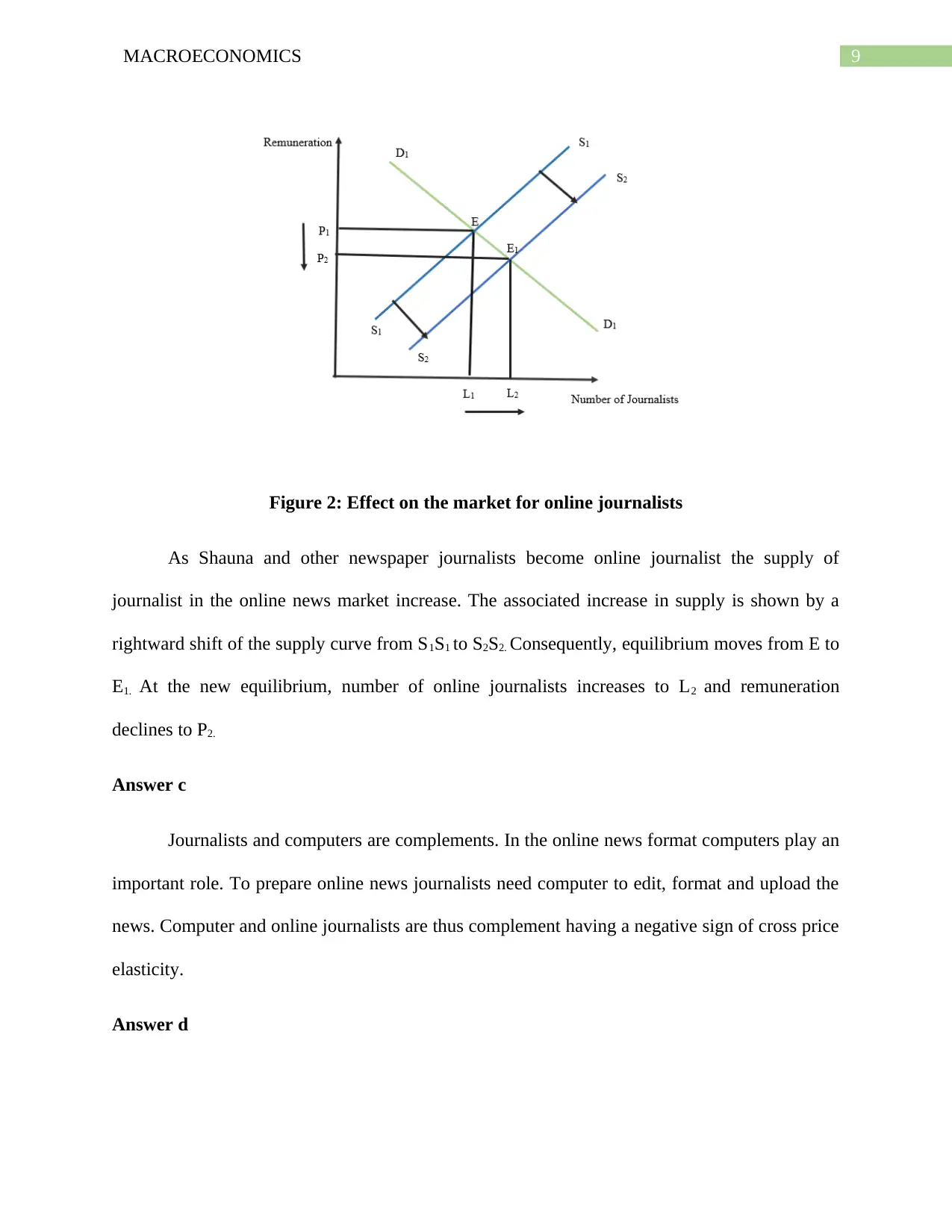
9MACROECONOMICS
Figure 2: Effect on the market for online journalists
As Shauna and other newspaper journalists become online journalist the supply of
journalist in the online news market increase. The associated increase in supply is shown by a
rightward shift of the supply curve from S1S1 to S2S2. Consequently, equilibrium moves from E to
E1. At the new equilibrium, number of online journalists increases to L2 and remuneration
declines to P2.
Answer c
Journalists and computers are complements. In the online news format computers play an
important role. To prepare online news journalists need computer to edit, format and upload the
news. Computer and online journalists are thus complement having a negative sign of cross price
elasticity.
Answer d
Figure 2: Effect on the market for online journalists
As Shauna and other newspaper journalists become online journalist the supply of
journalist in the online news market increase. The associated increase in supply is shown by a
rightward shift of the supply curve from S1S1 to S2S2. Consequently, equilibrium moves from E to
E1. At the new equilibrium, number of online journalists increases to L2 and remuneration
declines to P2.
Answer c
Journalists and computers are complements. In the online news format computers play an
important role. To prepare online news journalists need computer to edit, format and upload the
news. Computer and online journalists are thus complement having a negative sign of cross price
elasticity.
Answer d
Paraphrase This Document
Need a fresh take? Get an instant paraphrase of this document with our AI Paraphraser
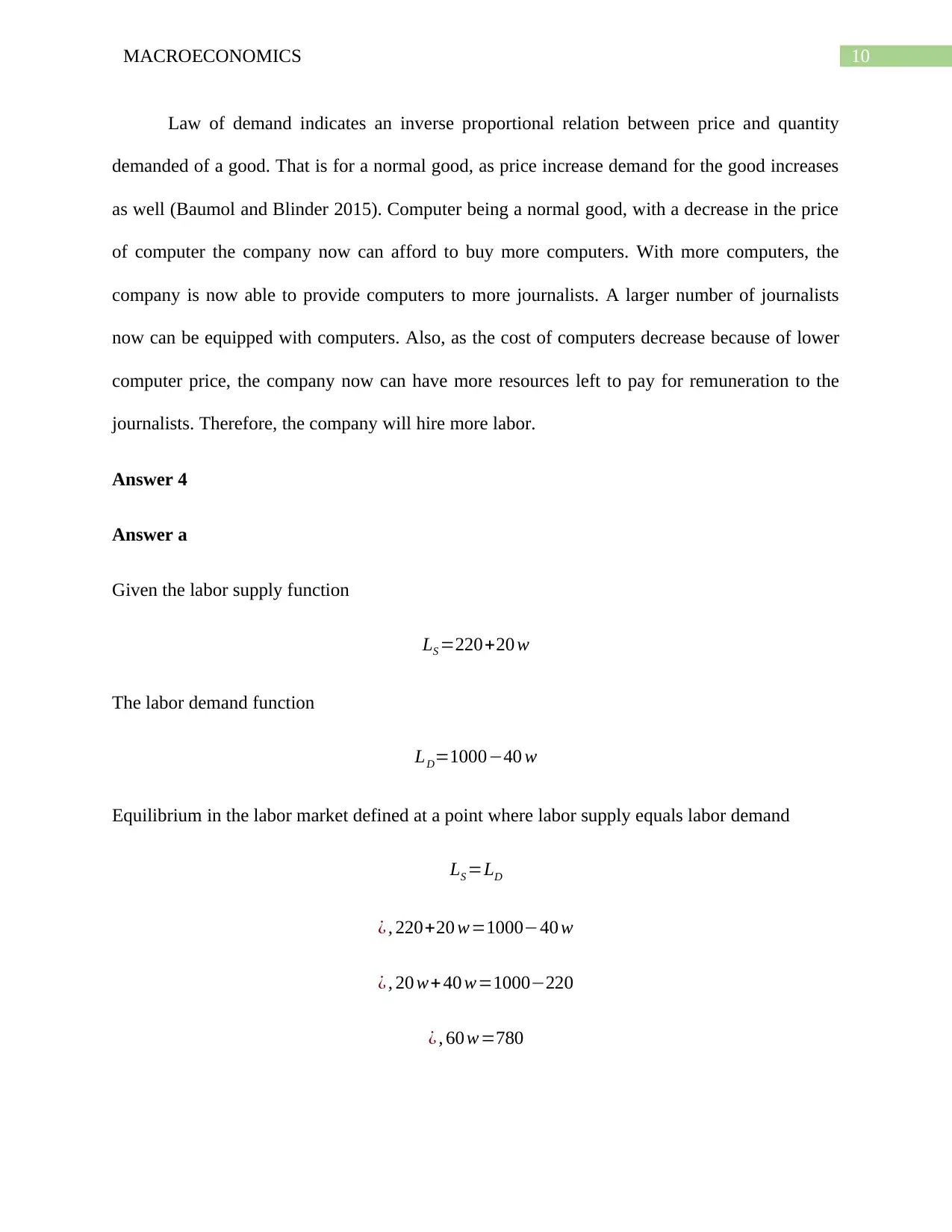
10MACROECONOMICS
Law of demand indicates an inverse proportional relation between price and quantity
demanded of a good. That is for a normal good, as price increase demand for the good increases
as well (Baumol and Blinder 2015). Computer being a normal good, with a decrease in the price
of computer the company now can afford to buy more computers. With more computers, the
company is now able to provide computers to more journalists. A larger number of journalists
now can be equipped with computers. Also, as the cost of computers decrease because of lower
computer price, the company now can have more resources left to pay for remuneration to the
journalists. Therefore, the company will hire more labor.
Answer 4
Answer a
Given the labor supply function
LS =220+20 w
The labor demand function
LD=1000−40 w
Equilibrium in the labor market defined at a point where labor supply equals labor demand
LS =LD
¿ , 220+20 w=1000−40 w
¿ , 20 w+ 40 w=1000−220
¿ , 60 w=780
Law of demand indicates an inverse proportional relation between price and quantity
demanded of a good. That is for a normal good, as price increase demand for the good increases
as well (Baumol and Blinder 2015). Computer being a normal good, with a decrease in the price
of computer the company now can afford to buy more computers. With more computers, the
company is now able to provide computers to more journalists. A larger number of journalists
now can be equipped with computers. Also, as the cost of computers decrease because of lower
computer price, the company now can have more resources left to pay for remuneration to the
journalists. Therefore, the company will hire more labor.
Answer 4
Answer a
Given the labor supply function
LS =220+20 w
The labor demand function
LD=1000−40 w
Equilibrium in the labor market defined at a point where labor supply equals labor demand
LS =LD
¿ , 220+20 w=1000−40 w
¿ , 20 w+ 40 w=1000−220
¿ , 60 w=780
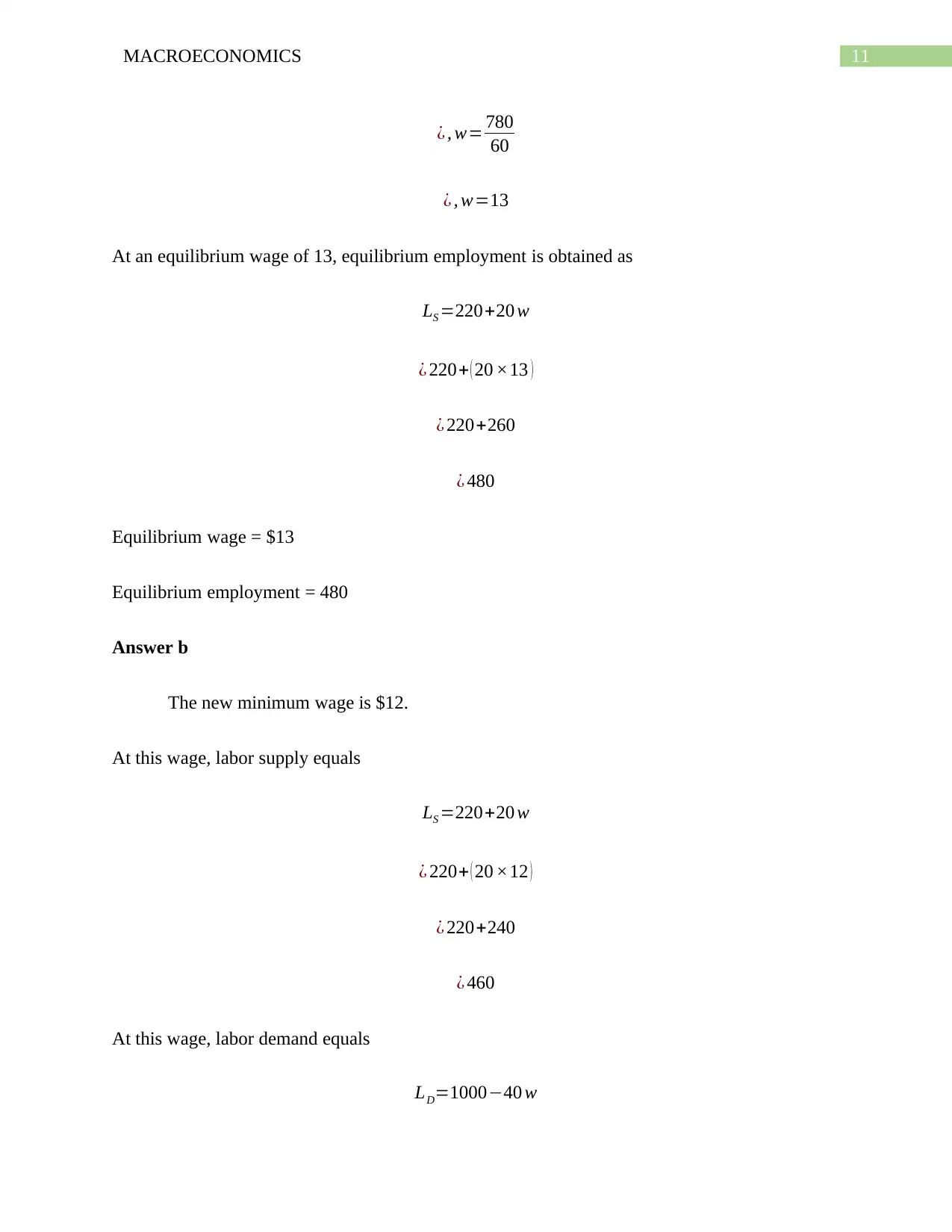
11MACROECONOMICS
¿ , w= 780
60
¿ , w=13
At an equilibrium wage of 13, equilibrium employment is obtained as
LS =220+20 w
¿ 220+ ( 20 ×13 )
¿ 220+260
¿ 480
Equilibrium wage = $13
Equilibrium employment = 480
Answer b
The new minimum wage is $12.
At this wage, labor supply equals
LS =220+20 w
¿ 220+ ( 20 ×12 )
¿ 220+240
¿ 460
At this wage, labor demand equals
LD=1000−40 w
¿ , w= 780
60
¿ , w=13
At an equilibrium wage of 13, equilibrium employment is obtained as
LS =220+20 w
¿ 220+ ( 20 ×13 )
¿ 220+260
¿ 480
Equilibrium wage = $13
Equilibrium employment = 480
Answer b
The new minimum wage is $12.
At this wage, labor supply equals
LS =220+20 w
¿ 220+ ( 20 ×12 )
¿ 220+240
¿ 460
At this wage, labor demand equals
LD=1000−40 w
⊘ This is a preview!⊘
Do you want full access?
Subscribe today to unlock all pages.

Trusted by 1+ million students worldwide
1 out of 17
Related Documents
Your All-in-One AI-Powered Toolkit for Academic Success.
+13062052269
info@desklib.com
Available 24*7 on WhatsApp / Email
![[object Object]](/_next/static/media/star-bottom.7253800d.svg)
Unlock your academic potential
Copyright © 2020–2025 A2Z Services. All Rights Reserved. Developed and managed by ZUCOL.





